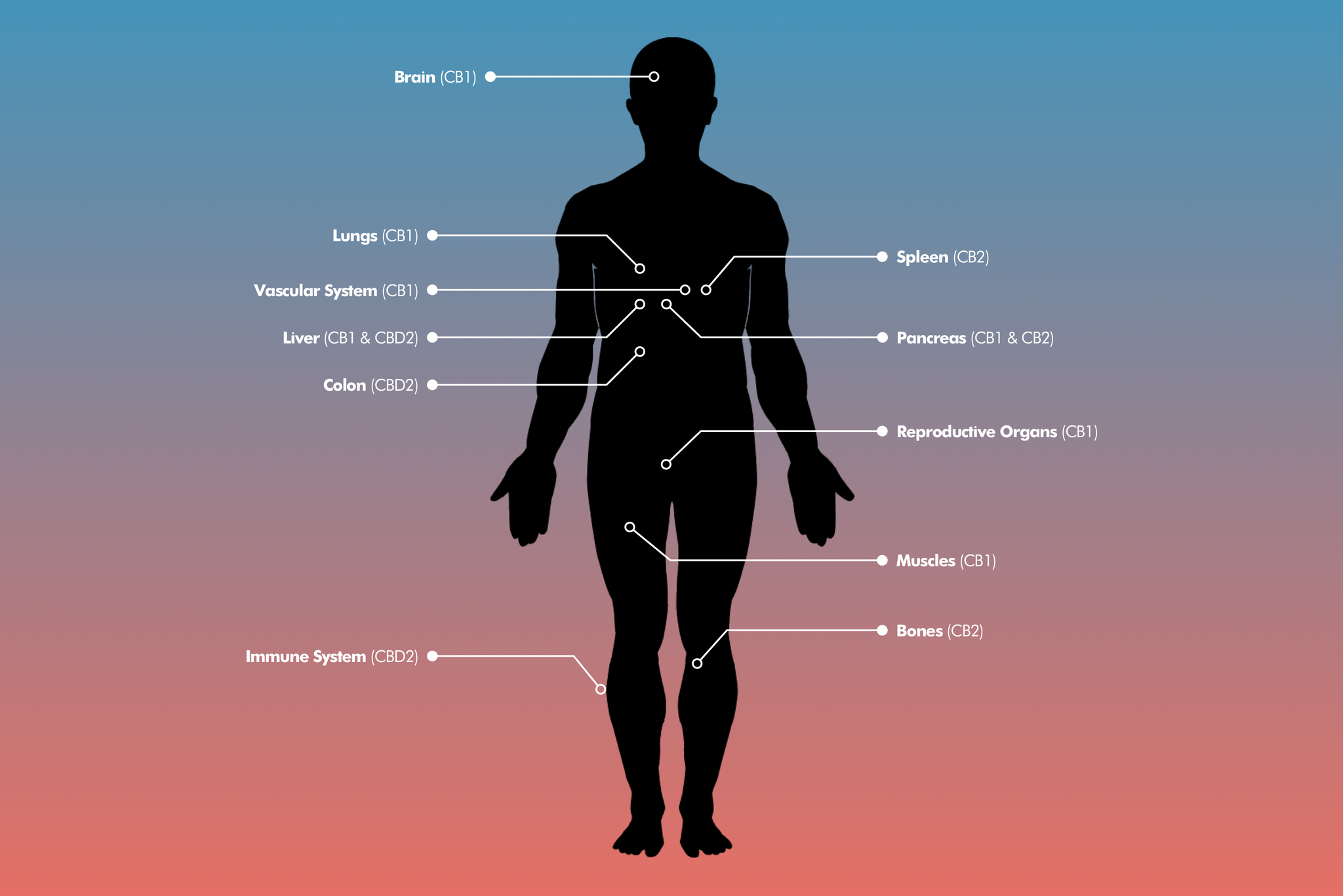Biology and Chemistry of CBD
ENDOCANNABINOID SYSTEM
The Endocannabinoid System, though relatively newly discovered, is extremely important and is responsible for two basic activities:
1. Modulate pleasure, energy, and well-being.
2. Slowly nudge the body back to health in the face of injury and disease.
The complexity of how it accomplishes these tasks has generated an astonishing amount of research in the last several decades, culminating in a basic understanding of the scope of this system only within the last ten years. There is still a great deal to be discovered about it, and it is only beginning to be included in the curriculum at medical schools and incorporated into clinical practice. An informal 2014 survey of U.S. medical schools showed that only 13 percent of institutions covered it at all in their training of new doctors.

In 1988 researchers discovered the cannabinoid-1 (CB1) receptor. The cannabinoid-2 (CB2) receptor was uncovered about five years later. One year before the CB2 receptor was discovered, a team headed by Raphael Mechoulam was tracking down the first endocannabinoid-signaling molecule, arachidonoyl ethanolamide (AEA). A few years later, they identified it and named it anandamide, combining the Sanskrit word meaning bliss (ananda) and the chemical name for a key part of the molecular structure of this compound (amide). Next, Mechoulam’s group identified the second endocannabinoid-signaling molecule, 2-arachidonoyl glycerol (2-AG). This discovery was followed by the search for and discovery of the enzymes responsible for synthesizing and breaking down AEA and 2-AG a little more than a decade ago, with the understanding of this whole system still unfolding to this day.
Due to its part in restoring balance when illness or injury occurs, the endocannabinoid system plays a critical role in regulation of disease. Researchers Pacher and Kunos stated in a 2013 review article that “modulating Endocannabinoid System activity may have therapeutic potential in almost all diseases affecting humans, including obesity/metabolic syndrome, diabetes and diabetic complication, neurodegenerative, inflammatory, cardiovascular, liver, gastrointestinal, skin diseases, pain, psychiatric disorders, cachexia, cancer, chemotherapy induced nausea and vomiting, among many others.” The importance of this system to our survival and well-being cannot be overstated.
The current understanding of this system is that it consists of the following:
Two receptors:
1. Cannabinoid-1 (CB1) receptor
2. Cannabinoid-2 (CB2) receptor
Two signaling molecules:
1. arachidonoyl ethanolamide (AEA or anandamide)
2. 2-arachidonoyl glycerol (2-AG)
Five enzymes:
1. DAGL-α (for synthesis of 2-AG)
2. DAGL-β (for synthesis of 2-AG)
3. NAPE selective phospholipase-D (for synthesis of AEA)
4. MAGL (for breakdown of 2-AG)
5. FAAH (for breakdown of AEA)
Additionally, several other possible ways that AEA is synthesized are currently being evaluated. It is also clear that this system is not confined to working solely within its own boundaries. Not surprisingly, it appears to interact robustly with several other non-cannabinoid systems in the body, to accomplish its tasks of regulating disease and well-being, including the endorphin system, the immune system, and the vanilloid system (the system that is responsible for transforming pain from acute to chronic). In modifying these other systems, the endocannabinoid system regulates inflammation, pain, bone health, formation of new nerve cells, fat and sugar processing, mood, energy, brain health, and hormone balance.
The endocannabinoid system has several unique and remarkable actions. AEA and 2-AG are “on demand” substances. They exist as common, spare molecular parts until CB1 receptors or CB2 receptors increase in the central nervous system or in other organ systems in the body. When this occurs, the transmitters are constructed on demand, work within seconds, and disappear into spare parts again. They are gone almost as fast as they appear.
We have this system built into us that monitors the body’s constant struggle between building itself up (anabolism) and breaking itself down (catabolism). When it detects too much of either, it appears, and almost as rapidly disappears, to nudge the body back to normal. This is a system that does not store up its main components but creates them on demand. It is the “ghost in the machine”: responsible for rebalancing the most essential systems in the body to control pain, mood, inflammation, energy, wellness, and illness. It shifts its role from maintaining a balance between physical buildup and breakdown to fighting disease and injuries. The complex interplay of this system with other body and brain systems involves interaction of the endocannabinoids with endorphins, hormones, cytokines, growth factors, pleasure molecules, immune cells, connective tissue system, bone metabolism, nerve and glial cell inflammation, cell regeneration, and programmed cell death. Needless to say, this is a system of immeasurable importance, and we are in the early stages of understanding the rich complexities at play.
The greatest number of CB1 receptors is located in the brain, while CB2 receptors are more numerous in the peripheral body. AEA and 2-AG signaling molecules, regardless of location, activate both receptor types. CB1 receptors activated in the brain result in an experience of pain relief, anxiety relief, mood stabilization, well-being, and pleasure. When brain-based CB2 receptors are activated, local anti-inflammatory responses occur. This does far more than relieve pain, as it has become clear that chronic brain inflammation is involved in post-traumatic stress disorder, depression, and autoimmune disorders.
The CB2 receptors, while present in small quantities in the brain, are present in high quantity in the peripheral body in all tissue types but themselves from detection. Activation of CB2 receptors unmasks this cloaking. CB2 receptors located on bone-forming cells activate bone formation, when stimulated, reversing osteoporosis. Activated CB1 receptors also affect the release of other neurotransmitters, including norepinephrine, serotonin, dopamine, orexin, histamine, GABA, and endorphins. Since CB1 receptors are most frequently located in the autonomic nervous system, they affect many of the automatic functions in brain and body, resulting in fine-tuning of everything from breathing and heart rate to connective tissue health and metabolic rate.
In health and illness, CB1 and CB2 receptors have a profound effect upon the gut—the authors of a 2016 study concluded that virtually all major GI functions are controlled by the endocannabinoid system. While CB1 receptor activation promotes increased blood lipid levels and liver fibrosis, CB2 receptors decrease blood lipid levels, fibrosis, and liver inflammation, an example of how these receptors frequently have opposite effects in the body. Typically, this appears to happen in illness-related conditions rather than normal states.
Another example of this opposing behaviour is the deterioration of heart health when CB1 receptors are activated during cardiac disease, while CB2 receptors promote cardiac health in such a case. Within CB1 receptors, this behaviour can also occur in muscle tissue, when activation of CB1 receptors may either promote or inhibit energy use, leading to muscle formation or destruction.
The entire endocannabinoid system plays a critical role in male and female fertility, as well as implantation and embryo development CB1 and receptors are highly involved in suppressing skin inflammation and melanoma formation. Activation of CB1 and CB2 receptors plays a role in how the brain develops in the growing embryo, which also affects the development of nerve cells that produce GABA and slows down excessive activity in the brain. Furthermore, CB1 and CB2 receptors are involved in embryonic brain development, health, protection, and regulation of intellectual function of nerve cells. The endocannabinoid system is also involved in new nerve cell formation in the adult brain, and the CB2 receptor is particularly important in this matter. Hence, the endocannabinoid system is highly involved in regulation of adult neuroplasticity throughout life. CB1 and CB2 receptors, in both their complexity and their subtlety, have profound effects upon health, illness, and development.
The activity of AEA and 2-AG on the CB1 receptors also affects wellness receptors, but they each activate both receptor types. These two signaling molecules even regulate each other’s levels in the brain. In the brain, they not only oppose inflammation but also are involved in the trimming away of old synapses to make way for creation of new ones. 2-AG blocks an animal model of multiple sclerosis and causes bone breakdown and osteoporosis. Combined with AEA and the CB1 receptor, 2-AG protects against neurodegenerative conditions, including Alzheimer’s disease and other dementias. AEA-blocking CB1 receptors inside of nerve cells clears beta amyloid and the inflammation it creates to prevent nerve cell death, one of the major processes in Alzheimer’s disease.
Although AEA and 2-AG work on CB1 and CB2 receptors, they also influence processes in the body without working on these cannabinoid receptors. They attach to both nerve cells and glial cells in the brain and work deeply in the inflammatory system in the body on multiple aspects of inflammation. AEA and 2-AG also promotes sleep and blocks anxiety. The endocannabinoid system is tumor suppressing in many types of cancer, including breast cancer, prostate cancer, ovarian cancer, thyroid cancer, endometrial carcinoma, liver cancer, colon carcinoma, bone cancer, glioma, glioblastoma, non-melanoma skin cancer, melanoma, leukemia, lymphoid tumors, and metastatic cancer.
The endocannabinoid system also has enzymes that work on the raw material in the body to make AEA and 2-AG and subsequently break them down. Unfortunately, drugs that completely block these enzymes have had profound negative effects on the body, resulting in symptoms ranging from brain damage to death, which demonstrates the complexity, richness, and importance of the endocannabinoid system to sustain life. Unlike the endocannabinoid system, drugs do not work in a pinpoint fashion. Their effects tend to be more global, and their activity on this profound system with such far-reaching effects is very risky. “As might be predicted, a drug that blocks CB1 neuromodulation at synapses for the major stimulatory (in the case of glutamate) and inhibitory (in the case of GABA) transmitters throughout the brain would be likely to produce multiple ‘off-target’ effects.”
In summary, the endocannabinoid system is newly discovered and is an extremely important system to our survival. It maintains and restores balance in multiple ways throughout the body, which affects varied issues regarding health and disease. If injury or disease occurs, the system shifts from one that regulates well-being, pleasure, and energy to one that restores balance and normal functioning processes. The system simultaneously pinpoints its actions and is active throughout the body. It is present throughout the body and brain and appears and disappears in a matter of seconds. It affects conditions as varied as multiple forms of cancer, heart disease, osteoporosis, degenerative brain diseases, inflammation, pain, and mood.




